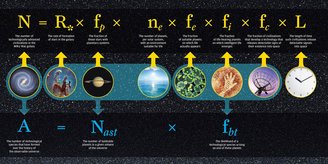Extraterrestrial life remains a great mystery to humanity. Despite all efforts to find evidence, the majority of the scientific community does not believe in the existence of intelligent alien civilizations. Some scientists have even created theories proving this. How is it practically impossible for another type of intelligent creature to exist?.
The Fermi Paradox is one of the hypotheses suggesting that ETs probably do not exist in the universe. This idea suggests that if an advanced civilization existed, humanity would likely have found some kind of evidence.
But not everyone thinks the same way; There are also experts who evaluate the possibility of aliens. The Drake Equation is a formula developed by American astronomer and astrophysicist Frank Drake in 1961 that aims to estimate the number of extraterrestrial civilizations that could spread throughout the Milky Way.
“The Drake equation is the equation intended to produce the N number of technically advanced civilizations in the Milky Way as a function of other astronomical, biological, and psychological factors. Formulated mostly by North American astrophysicist Frank Drake, this equation was first discussed in 1961 at Green Bank At a conference on ‘The Search for Extraterrestrial Intelligence’ (SETI) held at the National Radio Astronomy Observatory”, it is described in the encyclopedia Britannica.
Many recent discoveries suggest that the universe may actually host other forms of life much more simply than human life. For example, the existence of bacteria on some exoplanets. After all, does the Drake Equation answer whether we are alone in the universe?
What is the Drake equation
Although it is considered an interesting equation, researchers claim that the calculation is only a rough estimate of the number of active extraterrestrial civilizations in our galaxy that could communicate with Earth. The truth is that the equation was not created precisely to estimate the number of these civilizations, but to stimulate discussion at a meeting organized by SETI.
As Frank Drake explains, the equation uses certain concepts to take into account the hypothesis that there are other forms of life in the Milky Way that can communicate via radio waves.
The idea began to emerge after radio astronomy was accepted in science. After all, finding radio signals from other civilizations in the universe could change the world; That’s exactly what the SETI program does.
The calculation of the equation is as follows: N = R * × fp × ne × fl × fi × fc × L:
- N is the number of currently active communicating civilizations in our galaxy;
- R* is the rate at which stars are forming in our galaxy;
- fp is the ratio of stars with planets;
- ne is the number of planets that could potentially host life per star that has planets;
- fl is the fraction above that actually develops any form of life;
- fi is the fraction above that develops intelligent life;
- fc is the part of the above elements that enhances the interstellar communication capacity;
- L is the period when such communicative civilizations were active.
Calm down, I’ll explain it more simply. Drake illustrated that the same method can be used to estimate the number of students at a university. To do this, you need to find the number of freshmen entering the institution each year and multiply it by the average number of years these students will remain in the course. The result is the total estimate of undergraduate students.
“While planning the meeting, I realized we needed an agenda a few days in advance. I then wrote down everything you need to know to estimate how difficult it will be to detect extraterrestrial life. And as we looked at them, it became pretty clear that if we multiply all of these together, we get N, which is the number of detectable civilizations in our galaxy. The goal was not to look for primitive or primitive life forms, but to look for radio,” Drake said at the time.
Problems with the Drake Equation
Many scientists state that: The Drake equation should be used as a model for understanding how to look for life in the Milky Way, not for estimating the number of intelligent civilizations.

At the time he developed the calculation, Drake only knew the exact value of R*, the galaxy’s annual star formation rate. Since then, science has collected a lot of data that can be used to improve the equation; but others remain only guesses.
“And that, after all, was the reason for his invention. It is also noteworthy that this famous formulation encompasses all of the SETI Institute’s research activities, from our efforts to survey the harsh landscapes of Mars to our high-tech investigations with alien signals. It is the scaffolding on which the Institute is built,” the SETI website says of computing. The statement is included.
Now, The Drake Equation remains unsolved and correct data is not produced, but it remains one of the best calculations regarding the hypothesis of extraterrestrial life in our galaxy.
Did you like the content? So, stay up to date with more astronomical curiosities at TecMundo. If you wish, take the opportunity to learn about the Kardashev Scale of extraterrestrial civilizations.
Source: Tec Mundo
I’m Blaine Morgan, an experienced journalist and writer with over 8 years of experience in the tech industry. My expertise lies in writing about technology news and trends, covering everything from cutting-edge gadgets to emerging software developments. I’ve written for several leading publications including Gadget Onus where I am an author.












